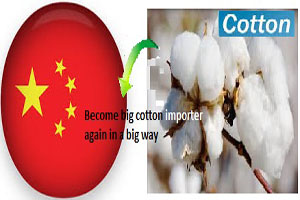
China likely to become big cotton importer again in a big way
YarnsandFibers News Bureau 2016-08-17 17:00:00 – New YorkChina is well on its way to becoming a big cotton importer after it unloads a huge state surplus of an estimated 52 million bales, believes Joe Nicosia, the senior head of cotton and merchandizing for Louis Dreyfus Commodities in Memphis as there is a dramatic decline in the cotton acreage contraction in China which has been one of the most remarkable developments seen in recent years.
Nicosia, speaking at the annual Cotton Roundtable, held at the New York Stock Exchange in New York City said that eight years ago, China was growing over 15.3 million acres of cotton. This year, it’s only going to plant 7.2 million acres. Even more remarkable is that China had dropped to 10.9 million acres a couple of years ago while the state reserve was still guaranteeing $1.20 a pound for their cotton growers.
Most of the losses in Chinese acres have been in their interior provinces, where farmers are planting less intensive crops such as corn.
Nicosia believes the losses in acreage are permanent. It is unlikely that they will see much of this area ever come back to cotton. This has major implications for the market down the road, as China is the world’s largest cotton consumer.
With China’s production output at a deficit to its consumption, China’s cotton stocks are being worked down at a rapid rate, Nicosia said. In two or three years, they could see China become an importer of 15 million bales again per year.
According to USDA, China is expected to produce around 22 million bales this marketing year and consume around 35 million bales, creating a deficit of around 13 million bales. Most of this will be met with cotton from its reserve, although China will import about 4.5 million bales, Nicosia said.
The downside to the long-term outlook is that since 2007, cotton demand has continued to suffer headwinds, mainly due to fashion trends favoring products made from manmade fibers. Polyester is at a strong price advantage to cotton in China, which is still the largest supplier of textile products to the world.
Polyester costs half as much as cotton to a Chinese mill. China has an advantage to making and selling these products and people currently want to buy them. This is one of the reasons why cotton’s share has continued to struggle.
According to Nicosia, the biggest changes have been in women’s fashion. Women’s leggings, yoga pants and tights are just about as common as jeans now. Similar trends have been occurring in women’s shirts. Ten years ago, the United States imported 2.8 million women’s cotton knit shirts. Today they are importing 2.1 million, a 25 percent reduction in cotton imports for women’s tops.
Market Intelligence
Ask for free sample Report

experience
Customer Base
dedicated team
Countries Served Worldwide




![Freitag unveils new Mono[P6] circular backpack](https://www.yarnsandfibers.com/wp-content/uploads/2024/04/Freitag.jpg)




